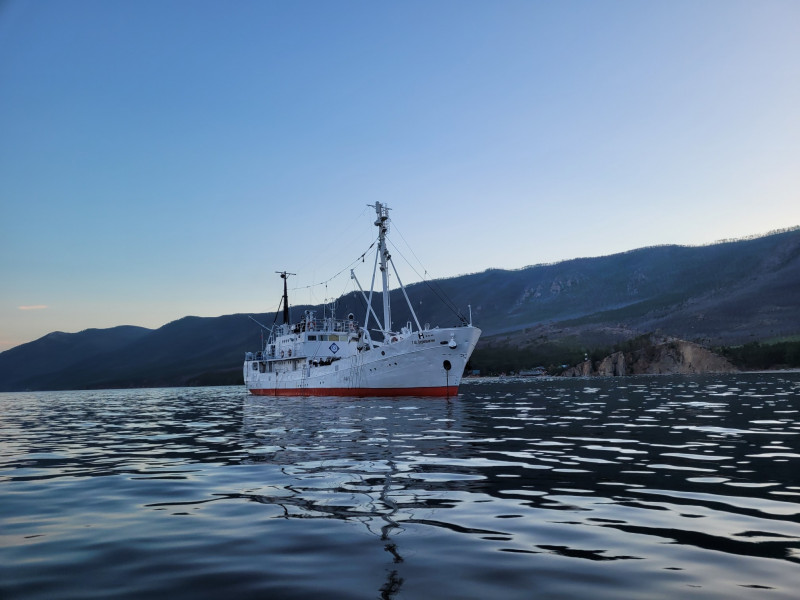Complex Circum-Baikal expedition on board the R/V “G.Yu. Vereshchagin” from May 30 to June 15, 2023
The expedition was carried out within the State assignments № 0279-2021-0005 “Study of transformations in the state of water bodies and watercourses of East Siberia in seasonal and long-term aspects in terms of climate changes, geological environment and anthropogenic pressure” (led by A.P. Fedotov), № 0279-2021-0004 “Investigation of the advective and turbulent water exchange of Lake Baikal and its impact on the lake ecosystem, risks of catastrophic events” (led by I.A. Aslamov), № 0279-2021-0008 “From the cell to the ecosystem: Investigation of the ultrastructure of hydrobionts and their communities in the evolutionary and ecological aspect by methods of cell biology and genomics” (led by Ye.V. Likhoshway), № 0279-2022-0004 “Assessment of environmental and economic aspects of the impact on Lake Baikal from existing and planned anthropogenic factors in the Baikal natural area, rational nature management, water and bio-resource potential of Lake Baikal” (led by M. Makarov), and № 0279-2021-0015 “Study of viral and bacterial communities as the basis for the stable functioning of freshwater ecosystems and an effective response in conditions of anthropogenic impact” (led by O. Belykh).
The expedition was aimed to carry out a complex monitoring of abiotic and biotic components of the Baikal ecosystem during the period preceding the spring homothermia, identifying patterns of their spatial and temporal dynamics; experimental study of mechanisms and processes affecting the distribution and circulation of matter in the water column taking into account temperature-density anomalies of deep natural waters in the conditions of modern climate change. Study of the distribution and transfer of physical and chemical (oxygen, biogenic elements) characteristics in the water column, gas exchange water-atmosphere.
In 2023, we plan to obtain new data on the impact of climate change and atmospheric circulation on temperature regime, on the distribution and abundance of plankton, and on the dynamics of biogenic elements.
Under the conditions of changing migration activity and structure of the Baikal cisco feeding stock, hydroacoustic studies of fish distribution in the pelagic zone of Lake Baikal were carried out. For this purpose, a hydroacoustic survey was conducted along 12 transverse reaches with a total length of 242.2 m.miles evenly covering the entire water area of the lake.
Data were obtained to study the processes of horizontal and vertical exchange including near-bottom and near-slope areas of the lake.
Sampling was carried out according to a standard grid of stations at fixed horizons from surface to bottom using a Carousel SBE-32 sampler equipped with 24 bathometers with a capacity of 5 liters. Water samples were taken for chemical, microbiological and metagenomic analysis as well as for studying the distribution and species composition of phytoplankton. Samples of phyto- and zooplankton were taken using a Juday and JOM nets. Fieldworks were carried out according to a standard grid of stations in three lake basins and in Barguzinsky bay, Chivyrkuisky bay and in the Maloye More Strait.
A total of 108 stations were covered including:
- 55 sampling stations
- 23 longitudinal section stations
- 26 cross-section stations
- 4 stations in bays
In addition, water samples for hydrochemical and microbiological analysis were taken in 11 rivers: Goloustnaya, Selenga, Anga, Sarma, Turka, Barguzin, Tompuda, Rel, Tyya, Verkhnyaya Angara and Kichera. Hydrophysical measurements were carried out at 53 stations by high-precision CTD-probe SBE-25 with additional sensors of dissolved oxygen and transparency.
Total number of samples:
- hydrochemical analysis – 242
- microbiological analysis – 144
- to determine the concentration of methane – 468
- zooplankton – 38
- metagenomic analysis – 32
- light microscopy – 32
- phytoplankton – 32
Simultaneously with the main works on the course of the research vessel, the water surface temperature was recorded, and gas bubble outlets (GOB) were monitored using a hardware-software complex based on a Furuno echo sounder with recording of echogram data.
At the stations, the upper (100 m) layer was probed with the JFE-Rinko STD probe with additional sensors of oxygen, turbidity, fluorescence, Ph, Eh, and PAR.
A downwelling zone (lowering of the water mass) was recorded in the area of Beryozovy Cape (Listvyanka settlement) according to vertical sounding data. Additional measurements were made and water samples were taken for isotopic analysis.
Maintenance work and service of agrometeorological station were done on Maly Ushkany Island and Cape Elokhin.














